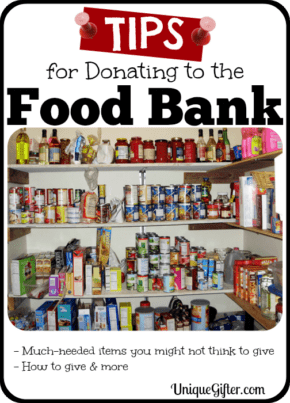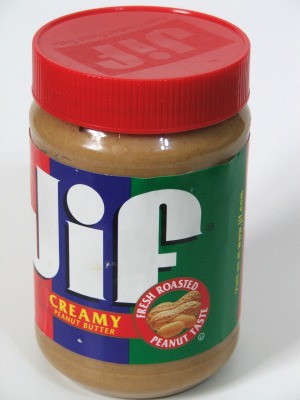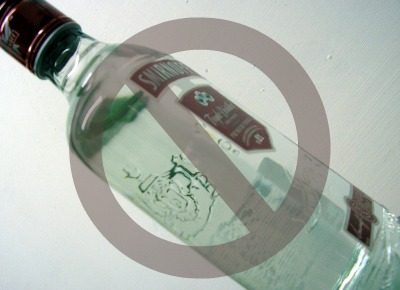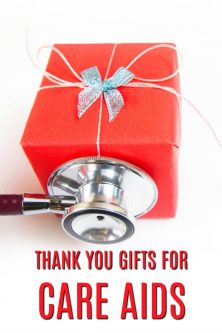Disclosure of Material Connection: Some of the links in this post may be "affiliate links." This means if you click on the link and purchase an item, I will receive an affiliate commission. Disclosure in accordance with the Federal Trade Commission's 16 CFR, Part 255. This site is a participant in the Amazon Services LLC Associates Program, an affiliate advertising program designed to provide a means for sites to earn advertising fees by advertising and linking to Amazon.
There are a lot of little tips for donating to food banks that can make your donations go even further and be the most valuable and usable things the food bank receives. Unfortunately, there are a lot of restrictions on donating to food banks and many donations end up having to be discarded! Many of these tips for donating to food banks also hold for donations to shelters and similar centres.

If you get a chance, I highly recommend following the Food Basket Challenge. It is an awareness campaign put on by the Saskatoon Food Bank, where community members, generally high profile folks or those in media, commit to spending one week living off only the contents of a food bank food hamper. They then share their experiences, feelings and thoughts through the week and once it is over. The insights are very interesting.
Tips for Donating to Food Banks
-
- First up, check with your local food bank or shelter to see if they have guidelines available.
- Not everywhere will accept travel-sized items, while some will gladly take them, if you have spares.
- Virtually all food banks cannot accept past-date food, even if you and I would still eat it.
- Short-dated (things which have expiry or sell-by dates in the next week or so) are also tough for food banks to deal with, because they won’t necessarily be able to process and hand out the items before they go “bad.”
- Many food banks will not accept glass, due to the safety risk and hassle created when things break or shatter. They are also heavier, which can be a problem for some folks who have to carry their food hampers home.
- Food banks cannot usually accept home-canned items, nor fresh food like fruits and vegetables. Some do have agreements with local farms or community gardens though, so it is best to check.
- When you are considering donating something, think about what else is required to make it edible. This quote sums some things up nicely:
Gemma Nancarrow Fresh items often which the sign clearly says that they can’t accept.
Also, I used to work in supported housing and we were given things from the foodbank that were near date and people hadn’t wanted and it included a lot of very spicy sauces, chilli con carne tins and stir fry sauces. As people said they didn’t have the money to add the fresh ingredients with it to make a meal.
- To that end, if you are donating to food banks, pause and think what else will be required to be added to your donation, in order to make it a meal.
- Think about the area you will be donating in. If everyone and their dog has a garden, tinned vegetables aren’t as useful. If the bulk of the population is of a particular ethnicity, do they eat or know how to use the things that you are going to donate?
- Some food banks and shelters have lists of their current needed items on their websites. If not, I recommend contacting them and then sharing the information they provide, for example on your Facebook feed, so other locals can find out about the needs.
- A friend of mine, back in university, made a habit of picking up one item for the food bank, every time she went grocery shopping. It was usually a can of soup that was on sale, or similar, just a regular part of her shopping. I love this approach, especially as it is a reminder to be thankful for the bounty we have in our lives. You won’t notice the $1-$2 added to your weekly shop.
- Check with food banks about their policies. Some will only give out healthy food, even if it is the holidays, so your donation of gourmet chocolate dipped biscotti may not make it to a recipient.
- Check if donating over the counter medications to your food bank is okay. If so, consider donating things like children’s vitamins, tylenol, advil, asprin, cold and flu medication and allergy medication. Remember that these medications usually cost quite a few dollars and people have to live without them, because they can’t afford them.
- Check if they can accept donations of frozen food – some can, some can’t.
The Best Food Bank Donation
Is cash. Yes, cash. We may feel good about donating things to the bins, to the kids coming to the door or to the events that ask us to bring things, but most food banks can make $1 go a lot further than you can. They have access to discounting deals with retailers, as well as bulk purchasing power that we can’t come near to achieving. That said, just because you do not donate cash, do not think that your donation is unwelcome! Some places will also happily accept coupons and pass them on to their clients.
Other Much Needed Things to Donate to Food Banks
- Shampoo
- Conditioner

- Deodorant
- Toothpaste
- Toothbrushes
- Dental Floss
- Soap: Body Wash, Bar Soap, Dish Soap, Hand Soap
- Laundry Detergent
- Dishwasher Detergent
- Paper Products: Toilet Paper, Paper Towel, Kleenex
- Cleaning Products: Windex, Toilet Bowl Cleaner, Spray Cleaner, Comet, Brushes, Cloths, Garbage Bags
- Reusable Containers and Ziplock Bags
- Contact Lense Solution
- Lightbulbs
- Sunscreen
- Bug Spray
- Lip Chap
- Over the Counter Medications, if they can be accepted
- Feminine Hygiene Products
- Razors
- Shaving Cream
- Diapers, Baby Wipes
- Infant Formula & Baby Food, Baby Toiletries
- Band Aids
- Q-Tips
- Telephone Calling Cards
- Pet Food & Cat Litter
The Best Foods to Donate to Food Banks

- Shelf-stable proteins: Peanut Butter/Nut Butters, Canned Tuna, Canned Salmon, Canned Beans, Dried Beans, Lentils, Pulses, Nuts, Trail Mix, Tahini, Shelf-stable Tofu
- Condiments for proteins: (ie things which will make tinned tuna into a meal) mayonnaise, mustard, ketchup, soya sauce, lemon juice, lime juice
- Whole Grain Basic Carbohydrates: Brown Rice, Whole Wheat Flour, Quinoa, Whole Wheat Couscous, Oatmeal, Whole Wheat Pasta, Healthy Breakfast Cereals
- Meals-in-a-Can or Box: Soup, Chili, Mac’n’Cheese, Noodle Bowls, Beans, Ravioli, etc
- Kid’s Lunch Foods: Juice Boxes, Fruit Snacks, Granola Bars, Fruit Cups, Pudding, Applesauce
- Hot Beverages: Coffee, Tea
- Gluten Free Items: variants such as rice pasta; Kosher items
- Pantry Staples: Pasta Sauce, Tinned Fruit, Tinned Vegetables, Jam, Dried Fruit, Crackers
- Basic Pantry Items: Cooking Oil, Salt & Pepper, Spices, Baking Soda, Baking Powder, Sugar, Flour, Yeast
- Shelf-stable Milk & Alternatives: Milk, Soy, Almond Milk, Hemp Milk, Rice Milk, Powdered Milk
For more resources, check out SuperFoodDrive.org for tips on organizing a healthy food drive.
Special Occasion Packs
- Some food banks are great at knowing when things like kid’s birthdays are around the corner. If you can find baking mixes which do not require additional ingredients that may not be available, such as eggs, consider putting together a tin tray, baking mix, icing and candles into a little “birthday kit.”
- Around the holidays you can do the same, with as many shelf-stable ingredients as possible. For example, stove-top stuffing, spice mixes, cranberry sauce, pancake mix, syrup, and scalloped potatoes.
What Not to Give a Food Bank
- Food that has been in your pantry forever because you don’t want to eat it – like that random can of escargot.
- Alcohol
- Past-date or expired food
- Home canned or prepared food
- Anything opened or with broken seals
[Photo – Creative Commons Attribution – Robert Benner Sr.]
What tips for donating to food banks do you have to add?











